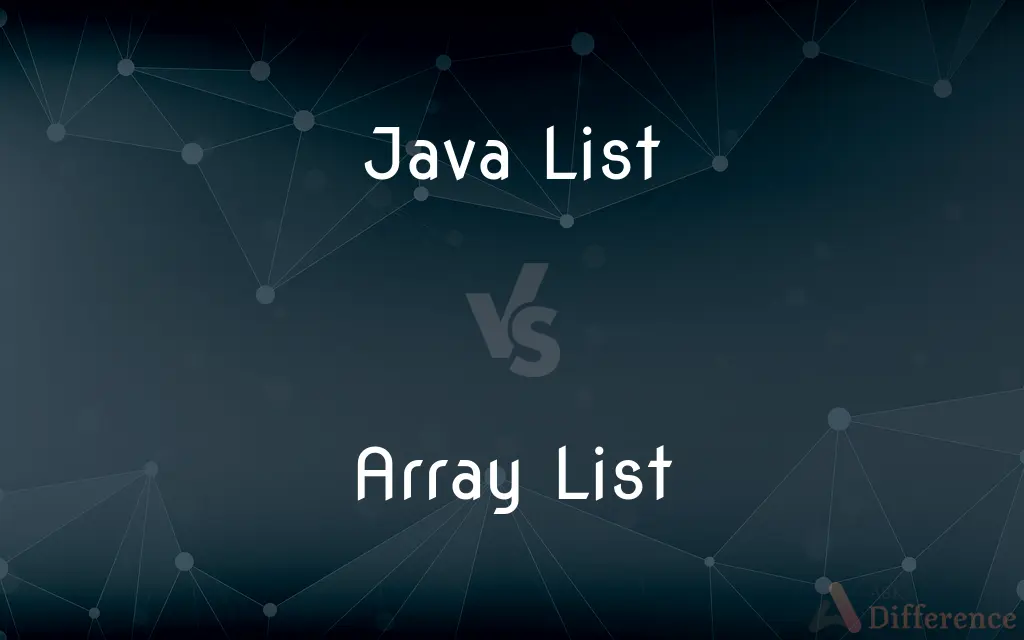Java List vs. Array List — What's the Difference?
By Tayyaba Rehman — Published on January 15, 2024
Java List is an interface for ordered collections; ArrayList is a resizable-array implementation of the List interface.

Difference Between Java List and Array List
Table of Contents
ADVERTISEMENT
Key Differences
A Java List is an interface that provides a contract for list implementations in Java, which includes ordered elements and allows for duplicate entries. ArrayList is a specific implementation of the Java List interface that uses a dynamic array to store its elements.
Java List defines methods for accessing, adding, and searching for elements without specifying the underlying structure. ArrayList provides concrete implementations of these methods and stores elements in an array that grows as needed.
Any class that implements the Java List interface can be used polymorphically. ArrayList is one such class and is known for its fast random access and quick iteration capabilities.
Java List allows for different implementations such as LinkedList, which is optimized for frequent additions and deletions. ArrayList, being array-based, is less efficient for operations that require frequent changes in the middle of the list.
The flexibility of the Java List interface means it can be implemented with various data structures, each with its performance trade-offs. ArrayList, with its underlying array, provides a general-purpose, efficient solution for list operations that do not require frequent reordering.
ADVERTISEMENT
Comparison Chart
Type
Interface
Concrete class
Underlying Data Structure
Abstract, not defined
Dynamic array
Resizability
Depends on implementation
Automatically resizable
Method of Storing Elements
Implementation-dependent
Contiguous memory storage
Performance Characteristics
Varies with implementation
Fast random access, slow insertions/removals
Compare with Definitions
Java List
An ordered collection interface.
List names = new LinkedList<>();
Array List
Efficient for end operations, less for middle insertions/removals.
Nums.remove(2); // Slower if it's a middle element
Java List
Facilitates polymorphic behavior of lists.
Void printList(List list) { /* ... */ }
Array List
Provides fast random access to elements.
Int num = nums.get(0);
Java List
Implemented by various classes like ArrayList and LinkedList.
List prices = new ArrayList<>();
Array List
Increases its size automatically when needed.
Nums.add(4); // Array size increases here if needed
Java List
Supports iteration and list operations.
For(String name : namesList) { System.out.println(name); }
Array List
A resizable-array implementation of the List interface.
ArrayList nums = new ArrayList<>();
Java List
Allows duplicate and null elements.
List numbers = Arrays.asList(1, 2, 2, 3);
Array List
Maintains insertion order and allows duplicates.
Nums.addAll(Arrays.asList(5, 6, 6, 7));
Common Curiosities
What is the Java List interface used for?
It's used to define a contract for list operations in Java.
What makes ArrayList different from other List implementations?
It uses a dynamic array, providing fast random access.
Are elements in a Java List ordered?
Yes, the List interface maintains elements in a sequential order.
Is ArrayList resizable?
Yes, ArrayList resizes automatically when more space is needed.
Can Java List be directly instantiated?
No, it's an interface and requires a concrete implementation like ArrayList.
Is ArrayList synchronized?
No, ArrayList is not synchronized; for a synchronized version, consider Vector or Collections.synchronizedList.
Does ArrayList allow null elements?
Yes, ArrayList allows null elements.
How do you declare a Java List?
List list = new SomeListImplementation<>();
Can we use Java List with for-each loops?
Yes, the List interface supports iterable operations.
How do you convert an ArrayList to an array?
Use the toArray() method provided by ArrayList.
How does ArrayList handle capacity increases?
It creates a new array larger than the previous one and copies the elements over.
What is the initial capacity of an ArrayList?
By default, ArrayList has an initial capacity of 10, but this can be specified in the constructor.
Can you store primitives in a Java List or ArrayList?
No, they store objects; for primitives, use the corresponding wrapper classes.
Is it possible to clone an ArrayList?
Yes, ArrayList provides a clone method.
Can I create a Java List with elements of different types?
You can declare a List with a wildcard, but it's not type-safe.
Share Your Discovery

Previous Comparison
Leasehold vs. Freehold
Next Comparison
Annually vs. Per YearAuthor Spotlight
Written by
Tayyaba RehmanTayyaba Rehman is a distinguished writer, currently serving as a primary contributor to askdifference.com. As a researcher in semantics and etymology, Tayyaba's passion for the complexity of languages and their distinctions has found a perfect home on the platform. Tayyaba delves into the intricacies of language, distinguishing between commonly confused words and phrases, thereby providing clarity for readers worldwide.
















































